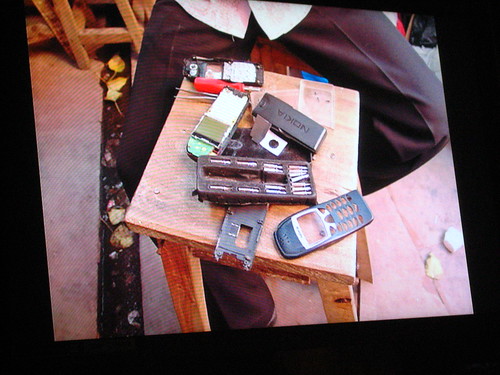Jan Chipchase is a user anthropologist for Nokia, who also writes a lovely (photo)blog, Future Perfect. His talk is about connectivity – specifically the connectivity of the mobile phone, which connects 3 billion of the world’s 6.3 billion people, and will rapidly connect another billion.
One question he frequently asks – “What do people carry?” He’s watched people for the past five years to see what devices people take out of the home. Ultimately, it’s wallet, keys and a mobile phone. These objects are survival gear – they address needs very low on Maslow’s hierarchy. Money lets you buy food, keys let you access your shelter, and your phone is a very useful “recovery device.” Chipchase watches these devices move towards a “center of gravity”, a place that these objects will all end up in your home and office.
(He’s right. My objects also include the small bag that contains my insulin and glucose meter. They gravitate to a spot in the kitchen, right next to where my wife’s things end up as well.)
“The way to remember everything is to have nothing to remember” – people have very complex
strategies for delegating things they need to know. You can’t delegate bodily functions and you don’t want to delegate entertainment, but people delegate almost anything else. Illiterate people – 799 million worldwide – are masters of delegation. Their contact lists get managed by people who can read and write on their behalf.
Some of these people are the microentrepreneurs who run phone kiosks in rural villages – they’re usually the only people in a community to have a phone. Increasingly, they’re also ATMs as well. A system called “sente” in Uganda – a word that means both “money” and “to send money” – works on top of the MTN cellphone network to allow remittance between Kampala and smaller towns. A person working in Kampala calls the mobile operator in a village, reads off a cellphone recharge code and the beneficiary. The mobile operator uses the code to recharge her phone and gives 80-90% of the value to the beneficiary. It’s a remarkable and creative system to connect the unbanked.
Creativity goes beyond business models – we see photos of mobile phone repair shops in China and India. In the US and Europe, we simply throw mobiles away. But in developing nations, a flat surface, a screw driver and a brush (to clean electronics contacts) is a shop. And technicians reverse engineer the technical manuals for these phones and distribute them in Hindi, Chinese and other languages.
The lessons of five years of studying connections and consequences:
– The immediacy of ideas – a big idea has to embrace everyone
– The immediacy of objects – things get adopted incredibly quickly
– The street will find uses for anything that meets basic needs
– Innovation will happen in ways we can’t anticipate
– People want to be part of the conversation
An excellent talk – one of my top five for the conference.

It puzzles me that Nokia (and I believe some other manufacturers) have only recently allowed users to download and upgrade the firmware in their phones. Bearing in mind the second-hand market in Asia and Africa, I wonder why I can’t download, say the last firmware version made of the now obsolete 9300. In Holland you have to go to an authorized dealer to get firmware upgrades – and they are usually not interested in supporting obsolete models (i.e. more than 6 months old). The new N-series upgrade software is out there, but not obsolete models long out of warranty. This firmware cannot have any commercial value – or am I missing something? It would certain help the repair shops.
Thanks for your reports on TED this year Ethan
Pingback: …My heart’s in Accra » Draft paper on mobile phones and activism
Pingback: Fire Up this Portable USB Charger for Your Off-the-Grid Power Needs | Uber Patrol - The Definitive Cool Guide
Pingback: Fire Up this Portable USB Charger for Your Off-the-Grid Power Needs - California King Sets
Comments are closed.